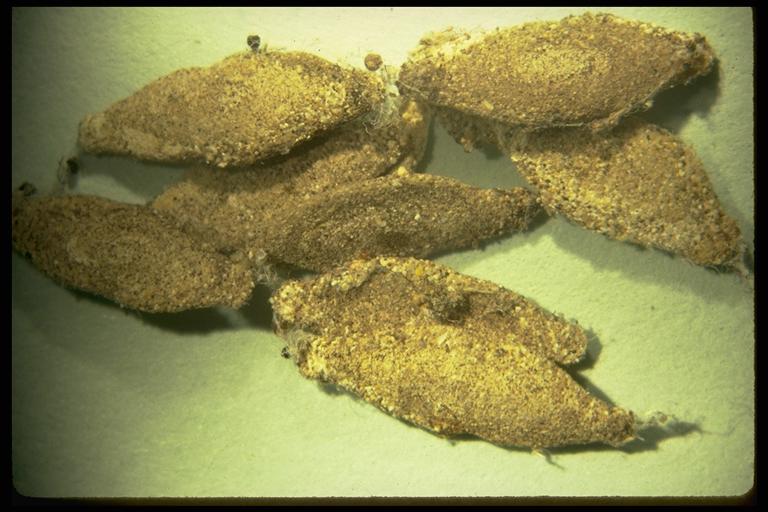
Casemaking clothes moth, Tinea pellionella Linnaeus (Lepidoptera: Tineidae), larval cases. Photo by C. L. Cole.
Common Name: Casemaking clothes moth
Scientific Name: Tinea pellionella Linnaeus
Order: Lepidoptera
Description: Adult moths have buff colored, 1/4-inch long wings fringed with hairs and held over their backs when at rest. The forewings of the casemaking clothes moth are brownish with three dark spots, while those of the webbing clothes moth are uniformly golden. Caterpillars of the casemaking clothes moths feed from within a somewhat flattened silken case which is dragged over the food source. Only their heads and legs appear outside, but from either end of the case. The webbing clothes moth feeds inside of silken burrows spun over the fabric surface. Larvae of carpet beetles (Coleoptera) do not produce silk.
If moths are observed flying around the home, they are more likely to be stored product pests such as the Indianmeal moth, Plodia interpunctella (Hübner) (Lepidoptera: Pyralidae) or Angoumois grain moth, Sitotroga cerealella (Olivier) (Lepidoptera: Gelechiidae). If damage to fabric is observed, look for silk webbing and granular-looking excrement (frass or fecal pellets) – symptoms caterpillar infestation.
Life Cycle: Female moths lay eggs, singly or in small clusters, that hatch into tiny caterpillars within 4 to 10 days. Larvae develop through several stages (the casemaking clothes moth develops through 5 to 45 instars) until they reach almost ½ inch long. They pupate in silken cases in which fibers from the infested fabric and excrement are incorporated. The life cycle may be completed within 2 months but may take several years.
Habitat and Food Source(s): Caterpillars have chewing mouthparts. Larvae feed mainly on wool, feathers, fur, hair, upholstered furniture, leather, fish meals, milk powders, lint, dust or paper. Sometimes they will damage fabrics of plant origin and synthetic materials soiled with oils or blended with animal fibers. The casemaking clothes moth will also feed on stored plant materials (e.g., spices, tobacco, hemp). These species avoid light in all stages and are located by examining stored animal product materials such as old clothing, woolens, yarn, furs, feather pillows and felt on piano strikers.
Pest Status, Damage: The casemaking clothes moth, Tinea pellionella Linnaeus, and the webbing clothes moth, Tineola bisselliella (Humel), are common in Texas. They feed mainly on stored fabric and materials of animal origin such as woolens and furs; medically harmless.
For additional information, contact your local Texas A&M AgriLife Extension Service agent or search for other state Extension offices.
Literature: Cocke 1979; Ebeling 1978.